For a Sustainable Energy Future
Energy leaders from the Asia Pacific region deliberate and arrive at seven key trends for a successful transition towards a sustainable energy future.
As the world’s fastest growing economic region today, Asia Pacific is witnessing increasing urbanization, rising population and monumental energy needs. With Asia Pacific accounting for more than half of global energy consumption, and with 10 percent of the population still lacking access to basic electricity, the question is how to bridge into an affordable, reliable and sustainable power supply, while improving energy access.
Following is the round-up of the key trends for a sustainable energy future as perceived by the thought leaders of the region. They have put spotlight on the regional challenges and the opportunities that can emerge out of it:
With 10 percent of the population of the Asia Pacific region still lacking access to basic
electricity, an affordable, reliable and sustainable power supply is the need of the hour.
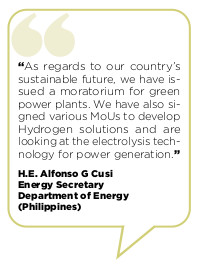
 Access to reliable, affordable, and sustainable energy supply is a necessity for economic growth
Access to reliable, affordable, and sustainable energy supply is a necessity for economic growth
“In the Philippines, about 95 percent of the society is energized. The biggest issue for us is the affordability of tariffs followed by concerns of energy security as our energy infrastructure is in the hands of the private sector. Therefore, we need to find the balance between accessibility, affordability, and sustainability. As regards to our country’s sustainable future, we have issued a moratorium for green power plants. We have also signed various MoUs to develop Hydrogen solutions and are looking at the electrolysis technology for power generation.”
H.E. Alfonso G Cusi
Energy Secretary
Department of Energy (Philippines)
 Ramp up the contribution of renewables for long-term sustainability
Ramp up the contribution of renewables for long-term sustainability
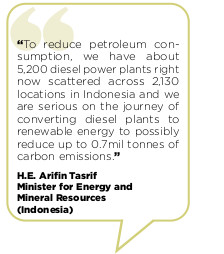 “Under our National Grand Energy Strategy, we hope to bring more renewable into the energy system of about 23 percent of the energy mix by 2025, its equivalent to additional 38GW renewable powerplant by 2035. We have a lot of resources that are fossil-based such as coal deposits, oil and natural gas as well as enormous renewable potential are our primary energy sources. In the next 10 years, we want to leverage on technology to build up capacity and infrastructure including 18 priority transmissions, 7 smart grid projects and renewable energy. Another program to reduce petroleum consumption, we have about 5,200 diesel power plants right now scattered across 2,130 locations in Indonesia and we are serious on the journey of converting diesel plants to renewable energy to possibly reduce up to 0.7mil tonnes of carbon emissions.”
“Under our National Grand Energy Strategy, we hope to bring more renewable into the energy system of about 23 percent of the energy mix by 2025, its equivalent to additional 38GW renewable powerplant by 2035. We have a lot of resources that are fossil-based such as coal deposits, oil and natural gas as well as enormous renewable potential are our primary energy sources. In the next 10 years, we want to leverage on technology to build up capacity and infrastructure including 18 priority transmissions, 7 smart grid projects and renewable energy. Another program to reduce petroleum consumption, we have about 5,200 diesel power plants right now scattered across 2,130 locations in Indonesia and we are serious on the journey of converting diesel plants to renewable energy to possibly reduce up to 0.7mil tonnes of carbon emissions.”
H.E. Arifin Tasrif
Minister for Energy and Mineral Resources (Indonesia)
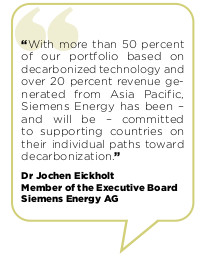
 Utilize technology for efficient and cleaner use of energy
Utilize technology for efficient and cleaner use of energy
“Asia Pacific is not only the fastest growing region but also the fastest transforming market. With more than 50 percent of our portfolio based on decarbonized technology and over 20 percent revenue generated from Asia Pacific, Siemens Energy has been – and will be – committed to supporting countries on their individual paths toward decarbonization. We drive the shift from nuclear and coal to gas and provide grid technologies to support the integration of renewables.”
Dr Jochen Eickholt
Member of the Executive Board
Siemens Energy AG

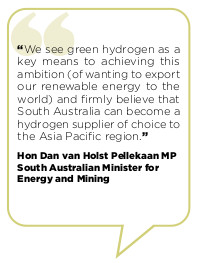 Embrace emerging and cleaner energy resources like Green Hydrogen
Embrace emerging and cleaner energy resources like Green Hydrogen
“We see green hydrogen as a key means to achieving this ambition (of wanting to export our renewable energy to the world) and firmly believe that South Australia can become a hydrogen supplier of choice to the Asia Pacific region. We have been a leader within Australia with our vision to become a world-class hydrogen supplier - as the first Australian jurisdiction to showcase our hydrogen vision through the 2017 Hydrogen Roadmap, and which was reinforced by the release of our Hydrogen Action Plan in 2019. The action plan outlines 20 specific actions across five important themes, with the objective of scaling-up renewable hydrogen production for domestic consumption and international export.”
Hon Dan van Holst Pellekaan MP
South Australian Minister for
Energy and Mining

.jpg) Digitalization and AI-driven intelligence will form the core of a future-proof and efficient transmission system
Digitalization and AI-driven intelligence will form the core of a future-proof and efficient transmission system
“Digitalization is the definition of the future. Utilities will stand to gain exponential benefits from digital solutions. On our end, digitalization helped us to maximize our asset management and performance especially during the pandemic, to support decision-making and analytics in addressing the changing loads of our distribution transformers. There are ample technical solutions that we can ride on but these require capital investment that requires regulatory approvals, and close collaboration with stakeholders on what projects to pursue and prioritize. In order to drive execution to become much cheaper, we will need the strong support from regulators and the government, as well as a close collaboration within the energy sector. The power to make Mother Earth a better place is in our hands.”
Ronnie L Aperocho
Senior Vice President
Networks Meralco Philippines

Image source: Siemens Energy

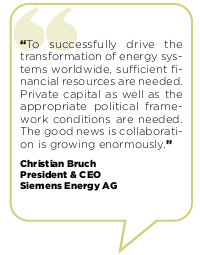 Access to capital at reasonable costs will accelerate the energy transition journey
Access to capital at reasonable costs will accelerate the energy transition journey
“To successfully drive the transformation of energy systems worldwide, sufficient financial resources are needed. Take Europe, where we need an estimated €30 trillion by 2050 to decarbonize all our systems. To accomplish this mammoth task, private capital is needed, as well as the appropriate political framework conditions. Again, it’s all about collaboration. The good news here – this is growing enormously.”
Christian Bruch
President & CEO
Siemens Energy AG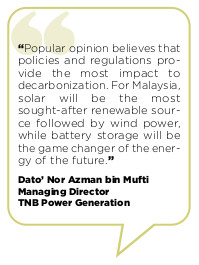 “In my view, achieving any nett zero carbon goals will require a complete supply chain of understanding, collaboration and agreement between the different parties, namely, legislators, government and consumers. The conversion from fossil fuel to renewable energy requires political will, legislations and policies in place, the willingness to push for change and agreement of consumers to pay a higher premium (with renewables). For power generators like TNB, we are more than happy to support and transform if there is some subsidy to defray the costs of our investment. Popular opinion believes that policies and regulations provide the most impact to decarbonization. For Malaysia, solar will be the most sought-after renewable source followed by wind power, while battery storage will be the game changer of the energy of the future.”
“In my view, achieving any nett zero carbon goals will require a complete supply chain of understanding, collaboration and agreement between the different parties, namely, legislators, government and consumers. The conversion from fossil fuel to renewable energy requires political will, legislations and policies in place, the willingness to push for change and agreement of consumers to pay a higher premium (with renewables). For power generators like TNB, we are more than happy to support and transform if there is some subsidy to defray the costs of our investment. Popular opinion believes that policies and regulations provide the most impact to decarbonization. For Malaysia, solar will be the most sought-after renewable source followed by wind power, while battery storage will be the game changer of the energy of the future.”
Dato’ Nor Azman bin Mufti
Managing Director
TNB Power Generation

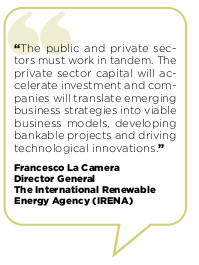 Collaboration among stakeholders is imperative for transformation of the energy landscape
Collaboration among stakeholders is imperative for transformation of the energy landscape
“To get to a sustainable energy future we have to join forces. Public sector and private sector must work in tandem for two main reasons. First, private sector capital will accelerate investment and there is a need for more public-private partnerships. Second, companies will translate emerging business strategies into viable business models, developing bankable projects and driving technological innovations. IRENA continues working with all stakeholders to accelerate energy transitions around the world.”
Francesco La Camera
Director General
The International Renewable
Energy Agency (IRENA)
Joining forces
With prices of renewables declining and with grid stabilization technology advancing, ramping up the contribution of renewable sources makes economic sense and will also drive long-term sustainability for the region. Governments can contribute with policies and regulations driving this change, and the industry could translate emerging business strategies into practical busines models, develop reliable projects and drive technological innovations. To accelerate the energy transition, all stakeholders must join forces and work towards the transformation.
With prices of renewables declining and with grid stabilization technology advancing,
ramping up the contribution of renewable sources makes economic sense.



 Facebook
Facebook.png) Twitter
Twitter Linkedin
Linkedin Subscribe
Subscribe